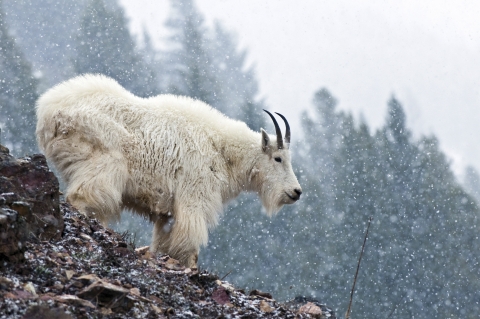The Rocky Mountain Goat Alliance (RMGA) is proud to spearhead production of a cutting edge public education piece on Rocky Mountain Goats. The final product will be a readily available and easily understandable short film highlighting mountain goat gender identification, ecology and biology, field judging, aging and trophy scoring.
While these topics have been covered in the past by some regional jurisdictions, most educational materials available to the public, specifically sportsmen and women, have grown dated by modern standards. It is imperative that we update these educational materials and make them broadly available as soon as possible.
RMGA feels it is our privilege and duty to lead the development of an educational tool that will positively benefit mountain goat populations across North America.
The mountain goat is one of the most difficult North American big game species to gender identify in the field. This often leads to unintentional harvesting of female goats across the continent, resulting in highly detrimental effects on local herds and population persistence.
Due to low reproductive and recruitment rates, the consequences of taking valuable females out of the population can have a significant negative effect on the growth and sustainability of individual populations. In some jurisdictions, such as Alaska, a point-based harvest management system is utilized where the harvest of females directly reduces the allowable mountain goat harvest in local hunt areas.

Making high-quality educational materials available to sportsmen and women will enable hunters to make informed and ethical decisions while hunting, and will lead to population sustainability and therefore consistent, long-term hunting opportunities. The reduction of female harvest is critical to the species’ conservation at local, regional and continent-wide scales.
Unlike the more commonly pursued deer family sub-species, members of the caprinae (goat-antelopes) typically occupy more rugged, marginal habitats and are much more sensitive to over-harvest, particularly of breeding age females. Most mountain goats do not reproduce until their fourth year of life. With reproductive rates at 65%, and average life expectancy in the wild at 8 years, one female goat may only successfully contribute 3 – 4 kids to a herd in her lifetime.
When an adult nanny is harvested, all her future reproduction potential is lost. Mountain goats exist in a ‘matriarchal’ society in which the oldest nannies play a key role in educating younger goats about seasonal habitat use patterns, so the loss of a dominant nanny can also effect the short-term survival of the entire herd.
Mountain goat hunters have a responsibility to fully understand the consequences of their decisions in the field. If provided with fundamental biological and ecological insight, it is hoped that hunters will avoid harvesting female goats due to the potentially negative consequences on the herd as a whole.
With minimal differences between average and trophy-sized billies, the field judging of a mountain goat can be exceptionally difficult.
In this video, we will be discussing in detail the key attributes of a record book mountain goat. Although not all hunters are trophy hunters, targeting of the largest billies can translate to the harvesting of the oldest animals.
Harvesting the oldest males in the herd has relatively small effect on the population productivity and persistence. These animals are also most likely to possess the qualities of a trophy mountain goat.
An ethical and ecologically aware hunter is, by default, a trophy hunter. In this video, trophy-identifying attributes will be highlighted in an easily understandable manner. This subject has never been published in tandem with the previous topics and contributes additional emphasis on harvest decisions and puts the actions of individual hunters into a broader conservation context.
The correct aging of a mountain goat is no easy task. The first and highest growth ring on the horn is made at 18 months of age during the animal’s second winter. Horn growth is so rapid during their first winter that no visible growth ring is made. Each ring after that represents another winter the animal survived on the mountain.
Scoring mountain goats for entry into either the Pope & Young or Boone & Crockett record books is a valuable way of archiving conservation milestones in North America. The presence of a “goliath” specimen can be attributed to the overall health and success of the population, management, genetics, and habitat quality.
Documentation of these impressive animals is vital to the history keeping and management of the species. Encouraging tag-holders to enter in these records is the first step in the preservation of the detailed story of the mountain goat.
Working in conjunction with state and provincial officials, we will distribute this educational piece to mountain goat hunters across North America. No matter where you choose to pursue mountain goats, the educational tool will be consistent and recognizable. This will have the added benefit of enhancing communications related to mountain goat management across jurisdictions.
Although primarily circulated through web-hosted outlets, the final product will also be available in DVD format for those who prefer a hardcopy.
The high quality, comprehensive production we intend to create will ensure the use of this video long into the future.
The continental reduction of nanny harvest depends on the successful reception of this educational film.
Your contribution to the RMGA Education Fund is essential for the production of this film.
With your help, we hope to raise the bar of hunter awareness and responsibility.
This educational video has the potential to have a long-lasting, positive influence on North America’s most iconic mountain ungulate.
We are generating a keystone educational piece and we are asking for your support. Please visit https://goatalliance.org/make-a-donation/ and make a donation today.
Thank you for your consideration, assistance, and interest in the conservation of mountain goats in North America.


